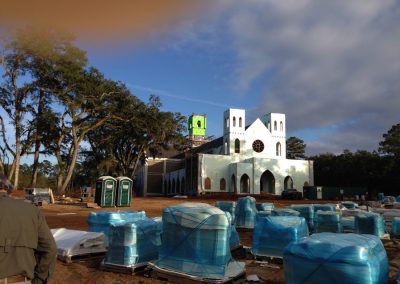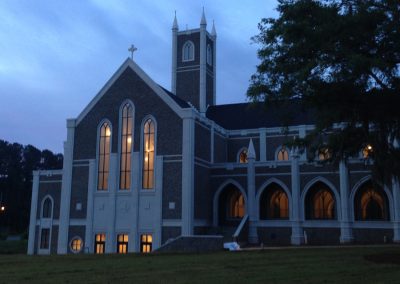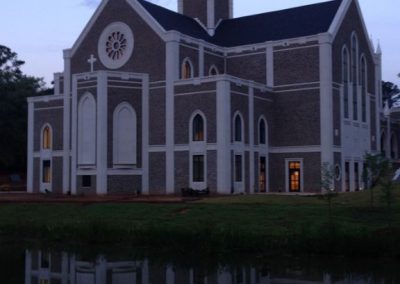
2014 Heavy Commercial Winner
St. Peter’s Anglican Church is a landmark, both for the ICF industry as a whole and in the city of Tallahassee, Fla., where it is located.
The story begins in 2005, when approximately 700 members and several prominent clergy members severed ties with the Episcopal Church.

Dozens of massive gothic arches were needed for arcades and windows. These were formed with custom-made V-bucks.
They immediately began planning for a permanent place of worship, one that would reflect their religious philosophy: a commitment to timeless truths, adapted to the modern world.
Father Eric Dudley, rector of the church, along with architect and church member Bradley Touchstone and several others toured the gothic cathedrals of Britain for inspiration. They wanted a building that would inspire worshipers and last for centuries. Something that would reflect architecturally what Dudley characterizes as “the solid, tradition-filled majesty of Anglican worship.”
Touchstone partnered with Karin Zawrotny at DodStone Group Architects to draw up plans. The 35,000-sq.-ft. church is designed around the cruciform floor plan used for more than a thousand years, and laid out on an East-West axis as is traditional for Anglican churches. Religious symbolism is ever-present. The two round stained glass windows in the gable ends have twelve “petals,” for the twelve apostles, and the flood of light through the eastern one represents Christ’s returning with the morning sun. Five Celtic crosses atop the structure represent the five wounds of Christ and the 24 spires represent figures from the Biblical Book of Revelation. Three massive gothic windows in the east gable represent the Holy Trinity.
The church will seat 750 comfortably, up to 1,000 with standing room only.
Though it may look ancient, the structure is built using the very latest technology. Zawrotny says, “The approach was to build a gothic style church in a manner that old world craftsman would do if they had access to the technologies available to us today.” She chose to use insulated concrete forms (ICFs), explaining, “ICF solved structural, thermal, and acoustical concerns with one product.”
She had used the Nudura ICF system on two prior projects, and was familiar with how the system worked. Construction was bid competitively, with Childers Construction Co. getting the nod as general contractor, and subbing the ICF installation to Masonry Incorporated. Childers bid the job to other suppliers, but Nudura proved to be the economical choice.
The forms are two-and-a-half inches of EPS foam on each side of the wall with eight or ten inches of steel-reinforced concrete sandwiched in the middle, providing unrivaled strength, energy efficiency, and sound absorption. ICFs were used on virtually all the exterior walls and a portion of the interior as well. Only the top of the central tower is steel frame construction. In total, the project used about 58,000 sq. ft. of ICF: 47,000 sq. ft of exterior wall plus 11,000 sq. ft on the interior.
Because ICF walls insulate so well, the cooling system was reduced by one-third compared to what concrete block would require. This reduction made it feasible for the church to utilize two smaller chillers, setting them up in parallel so that the second chiller is needed only when the structure is fully occupied (typically two days a week).
The acoustical performance of the ICF walls was another advantage. The main highway through town lies just to the east, and sound control was a critical concern. ICF walls eliminate that noise and provide a serene environment.
Numerous other issues, like concealing downspouts within the walls, were also simplified by using ICF.
Doyle Brown, writing for Tallahassee Magazine, describes the church as “a medieval cathedral built to LEED standards.”
Zawrotny says it is the most complex ICF project in the region. Most of the church used ICFs with an 8″ core, but the tall gable ends—68 feet at the apex—used 10” cores.
The interior and exterior walls are regularly punctuated with massive gothic windows. (Most are 15 feet high and eight feet wide, although several are larger.) These were formed with custom-made V-bucks which were then used as the template to cut the foam. V-buck’s ability to handle curved openings was also extremely useful in blocking out the massive round “rose windows” in the gables. These larger openings were reinforced with plywood below to make sure the curves didn’t buckle when the concrete cores were poured.
 The arcades—the columns separating the aisles from the main worship area are also ICF, and like the exterior walls, used dozens of gothic arches. Bruce Anderson, who supplied the V-buck for this project, estimates the project has more than 400 openings.
The arcades—the columns separating the aisles from the main worship area are also ICF, and like the exterior walls, used dozens of gothic arches. Bruce Anderson, who supplied the V-buck for this project, estimates the project has more than 400 openings.
The intersecting walls of differing thicknesses, the size and number of arched openings, and the height of the unsupported gables pushed the limits of this type of construction for this area.
The exterior façade is manufactured stone, and the beautiful timber-framed roof matches the traditional aesthetic of the building.
Built on a small rise, the church is visible for quite a distance. The hill also presented a construction challenge, as the foundation on the west side is 12 feet lower than the east. As the water table is close to the surface, an undercroft was built under the west end to house a crypt, as well as classrooms, a nursery, and church offices. This approach also minimized the amount of waterproofing needed.
Not surprisingly, the prominent location and unusual construction attracted considerable attention. Other contractors, architects, students, and building officials requested tours. Even the construction workers themselves knew they were working on an extraordinary project. Brown, the reporter who visited the site at the peak of construction says, “Each morning one of St. Peter’s priests arrives on the jobsite and, with hard hats off and heads bowed, the men are led in a prayer for safety and the guidance of God’s hand.”
The project faced rain delays at several key points and fell behind schedule. The construction deadline, though, could not be moved, as the archbishop performing the consecration was scheduled to arrive from Africa, and clergy from across the U.S. had also made plans to attend.
Childers, the GC, convinced his finish subcontractors to stagger their schedules so crews of one kind or another were working almost around the clock. This minimized interference and also allowed them to utilize the same scaffolding and lifts. They installed the altars, transept screens, pulpit, baptismal font, and other features—all hand-carved oak— and hung the life-sized crucifix made by parishioner Robert Mullins above the central altar.
In the end, the project finished on time, and was dedicated on schedule in June of 2014.
Already it has become a community landmark with directions referencing the church as a waypoint. The central bell tower, directly above the altar and illuminated at night, serves as a beacon to the community, both figuratively and literally.
 The church received a merit award from the AIA Tallahassee in December 2013. The jury commented, “The building truly captures the spirit of what a church of this denomination should feel like. The architect’s use of scale, proportion and rhythm is exemplary.”
The church received a merit award from the AIA Tallahassee in December 2013. The jury commented, “The building truly captures the spirit of what a church of this denomination should feel like. The architect’s use of scale, proportion and rhythm is exemplary.”
Architects were not the only group impressed with the building. Tour requests—from the congregation, local universities, the architectural community, and other builders—flooded in during construction, and haven’t really slowed down since completion. Dudley estimates the structure received over 750 visitors in the three months following consecration. Several of them have chosen to make the church their spiritual home.
If it’s European predecessors are any indication, this beautiful ICF church may be the center of Tallahassee’s Anglican community for centuries to come.
Location: Tallahassee, Fla.
Type: Worship Facility
Size: 35,400 sq. ft. (floor)
ICF Use: 58,000 sq. ft.
Cost: $9.2 million
Total Construction: 20 months
ICF Installation time: 180 days
Owner: St. Peter’s Anglican Church
General Contractor: Childers Construction Co.
ICF Installer: Masonry Incorporated
Architect: Touchstone Architecture/DodStone Group
Form Distributor: Nudura Corp.
ICF System: 8″ and 10″ Nudura
- Traditional Anglican church layout and appearance
- “Old World” craftsmanship with cutting-edge technologies
- Dozens of large gothic windows and arches
- ICF gables to 68 feet high
- Tight schedule to meet international dignitaries coming for dedication
2014_Project_Profile_St_Peters_Anglican_17
Dozens of massive gothic arches were needed for arcades and windows. These were formed with custom-made V-bucks.
2014_Project_Profile_St_Peters_Anglican_07
Finish subcontractors worked staggered shifts to meet the dedication deadline.
Like what you read?
Yearly Subscriptions Starting @ $30























































0 Comments